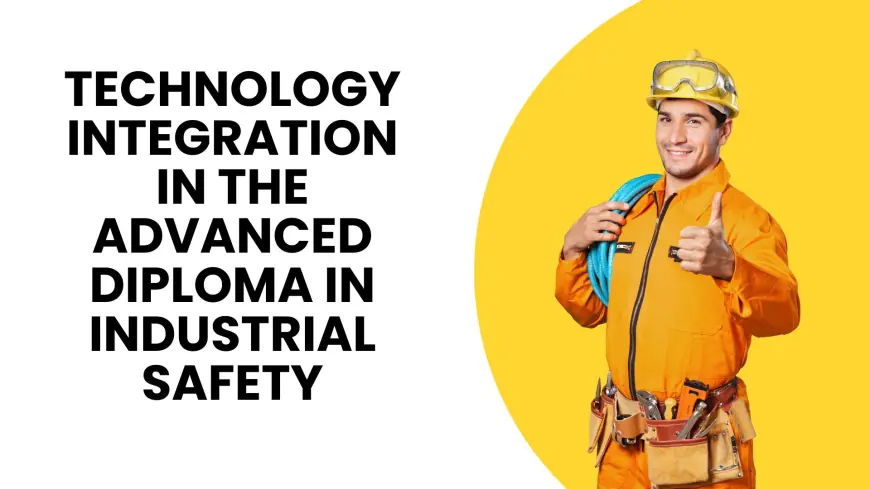Technology Integration in the Advanced Diploma in Industrial Safety

Introduction
The industrial sector is undergoing a significant transformation, driven by advancements in technology and the growing need for safer, smarter workplaces. In this rapidly evolving landscape, the Advanced Diploma in Industrial Safety has emerged as a crucial program for preparing safety professionals to meet modern safety challenges. One of the most impactful aspects of this diploma is the integration of technology into its curriculum. From simulation tools and data analytics to AI-driven risk assessments and IoT-enabled monitoring systems, technology is reshaping how safety is taught and practiced.
This article explores how technology is embedded in the Advanced Diploma in Industrial Safety, enhancing both learning outcomes and practical applications in real-world industrial environments.
1. Digital Learning Platforms and E-Content
The traditional classroom model has expanded to include e-learning modules, virtual classrooms, and interactive simulations. These platforms make safety education more accessible, especially for working professionals and distance learners.
-
Benefits: Learners can access course content anytime, from anywhere.
-
Interactive Modules: Use of videos, quizzes, case studies, and gamified content increases engagement.
-
Virtual Labs: Students can practice identifying risks and managing emergencies in simulated industrial environments.
This shift to digital platforms not only modernizes the delivery of education but also fosters deeper understanding through interactive experiences.
2. Virtual Reality (VR) and Augmented Reality (AR)
VR and AR technologies are revolutionizing safety training by providing immersive learning environments that replicate real-life hazards without putting trainees at actual risk.
-
VR Applications: Firefighting simulations, confined space training, chemical spill responses.
-
AR Applications: On-site hazard identification overlays, equipment maintenance guidance.
-
Outcome: Trainees develop muscle memory, quick decision-making skills, and situational awareness.
Such immersive technologies improve retention rates and make complex scenarios easier to understand, especially for high-risk industries like oil & gas, construction, and manufacturing.
3. Integration of IoT and Smart Sensors
Modern industrial safety heavily relies on the Internet of Things (IoT) for real-time data collection and monitoring. The Advanced Diploma curriculum now includes training on:
-
Wearable Devices: Monitoring worker vitals and fatigue.
-
Environmental Sensors: Detecting toxic gases, temperature changes, and pressure levels.
-
Smart Alarms: Automatically triggering alerts and evacuation protocols.
Students are taught to interpret sensor data and respond to alerts effectively. Understanding these systems is vital in industries that demand zero-error environments.
4. AI and Machine Learning in Risk Management
The integration of Artificial Intelligence (AI) and Machine Learning (ML) into safety education allows future professionals to understand and use data-driven insights to prevent accidents.
-
Predictive Analytics: Using historical data to foresee risks and implement preventive measures.
-
Pattern Recognition: Identifying unsafe behavior patterns or equipment malfunctions.
-
Automated Reports: AI tools assist in generating safety compliance documents.
By mastering AI tools, students can contribute to proactive safety cultures where prevention is prioritized over reaction.
5. Data Analytics and Safety Metrics
Data is the backbone of effective safety management. The curriculum introduces students to data collection, analysis, and reporting tools such as:
-
Excel and Power BI: For analyzing incident trends.
-
SCADA Systems: Supervisory Control and Data Acquisition in industries.
-
Dashboard Design: Real-time safety performance indicators.
This enables safety professionals to base decisions on solid data, improving overall operational efficiency and compliance.
6. Drones and Robotics in Safety Inspection
The use of drones and robotics in industrial safety is on the rise. These technologies help conduct inspections in hard-to-reach or hazardous areas.
-
Drone Training: Courses include drone operation for surveying construction sites or monitoring fire hazards.
-
Robotic Systems: Used for bomb detection, hazardous material handling, or equipment inspection.
Students are exposed to the regulatory frameworks and technical skills needed to operate such equipment, making them more versatile and job-ready.
7. Learning Management Systems (LMS) and Assessment Tools
The integration of LMS platforms ensures structured learning, timely assessments, and continuous tracking of learner progress.
-
Auto-Graded Assessments: Immediate feedback on quizzes and assignments.
-
Customized Learning Paths: Adaptive learning tools that cater to individual student needs.
-
Performance Analytics: Helping instructors and students identify strengths and areas for improvement.
Such systems enhance the academic experience and ensure that safety professionals graduate with a robust skill set.
8. Technology in Legal and Compliance Training
Compliance with OSHA, ISO 45001, NFPA, and other safety standards is a core part of the Advanced Diploma. Technology makes compliance training more effective.
-
Digital Audit Tools: Help simulate and conduct mock audits.
-
E-Regulations Access: Online access to global and regional safety laws.
-
Compliance Simulators: Allow students to role-play scenarios where they must ensure legal adherence.
This hands-on training using digital tools ensures that graduates can handle safety audits and inspections confidently.
9. Cloud-Based Collaboration Tools
With global operations and remote teams becoming the norm, the ability to collaborate online is essential.
-
Google Workspace / Microsoft 365: Training includes using shared docs, spreadsheets, and calendars.
-
Safety Apps: Platforms like SafetyCulture or iAuditor for mobile audits and checklists.
-
Communication Tools: Slack, Teams, and Zoom integrated into coursework.
These tools enable real-time communication, faster incident reporting, and team coordination in crisis situations.
10. Cybersecurity Awareness in Industrial Safety
As industrial systems become increasingly digitized, the threat of cyber-attacks on safety systems grows. The Advanced Diploma is evolving to include:
-
Cyber Risk Training: Recognizing threats to safety control systems.
-
Industrial Control System (ICS) Security: Protecting SCADA and PLC networks.
-
Data Privacy Compliance: Understanding how safety data should be stored and accessed.
Professionals equipped with both physical and digital safety knowledge are now in higher demand than ever before.
Note: For career growth visit best Institute of Fire Engineering and Safety Management
Conclusion
The integration of technology into the Advanced Diploma in Industrial Safety is not just a modern convenience—it’s a necessity. Today’s safety professionals must be as comfortable with a sensor dashboard as they are with a fire extinguisher. By blending traditional safety principles with cutting-edge tools like AI, VR, IoT, and robotics, this diploma ensures its graduates are future-ready.
As industries strive for higher standards of health and safety, technologically adept professionals will lead the charge—minimizing risks, maximizing efficiency, and ultimately saving lives.
What's Your Reaction?
 Like
0
Like
0
 Dislike
0
Dislike
0
 Love
0
Love
0
 Funny
0
Funny
0
 Angry
0
Angry
0
 Sad
0
Sad
0
 Wow
0
Wow
0

















































